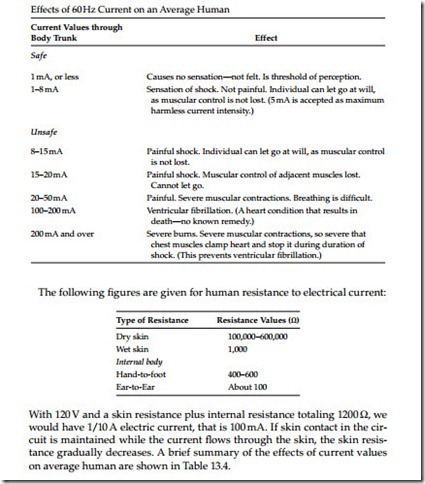Effects of Electrical Shock
Current is the killing factor in electrical shock. Voltage is important only in that it determines how much current will flow through a given body resistance. The current necessary to operate an l0 W light bulb has eight to ten times more current than the amount that would kill a lineman, that is, if it actually breaks through skin and body resistance and current of this amperage flows in the body. A voltage of 120 V is enough to cause a current to flow which is many times greater than that necessary to kill. Currents of 100 to 200 mA cause a fatal heart condition known as ventricular fibrillation for which there is no known remedy.
TABLE 13.4
Related posts:
Overhead Lines:Conductor Data
Medium-Voltage Switchgear and Circuit Breakers:AC Methods of Tripping and Circuit Breaker Closing
NUCLEAR POWER:NUCLEAR FUSION
The Current Situation and Perspectives on the Use of Nuclear Energy for Electricity Generation:Role ...
The Current Situation and Perspectives on the Use of Nuclear Energy for Electricity Generation:Decom...
Power Conditioning Devices:Ferroresonant Transformer
The Current Situation and Perspectives on the Use of Solar Energy for Electricity Generation:Concent...
Transformers:Single-Phase Transformers
HVDC Transmission for Offshore Wind Farms:Different Concepts for the Energy Conversion System in Off...
AN INTRODUCTION TO ELECTRICITY GENERATION
Maintenance Strategies, Dielectric Theory, Insulating Materials, Failure Modes, and Maintenance Impa...
Maintenance Strategies, Dielectric Theory, Insulating Materials, Failure Modes, and Maintenance Impa...
Testing and Commissioning of Protective Relays and Instrument Transformers:Types of Relay Tests
Criteria and Tools for Evaluating Wind Power Converter:Importance of Thermal Stress in Wind Power Co...
Measurements and instrumentation:Flow.
